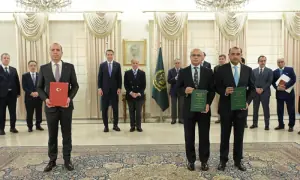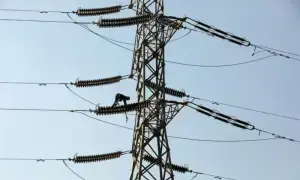US President Donald Trump’s tariffs are increasingly clogging up the wheels of a world economy which for decades were greased by predictable and relatively free trade.
Big-name multinationals, right down to niche e-commerce players last week cut sales targets, warned of job cuts and reviewed their business plans, while major economies revised down growth prospects amid bleak data read-outs.
While financial markets are betting that US and China will pull back from an all-out trade war and that Trump will cut deals to avert higher tariffs on others, the sheer uncertainty of where this ends has become a major drag factor in itself.
“US tariff policy is a serious negative shock for the world in the near term,” said Isabelle Mateos y Lago, group chief economist at French bank BNP Paribas.
“The US tariffs end-game may be further away and at a higher level than previously thought,” she said of blanket US tariffs currently set at a baseline of 10 per cent alongside higher, sector-specific charges on products such as steel, aluminium and autos.
Beijing said on Friday it was evaluating an offer from Washington to hold talks over 145pc US tariffs, to which it has responded with 125pc levies. Trump’s administration has also suggested it is close to deals with countries including India, South Korea and Japan to avert more tariffs in weeks to come.
In the meantime, companies such as Swedish appliances maker Electrolux slashed its outlook while Volvo Cars, computer gadget maker Logitech and drinks giant Diageo abandoned their targets on the uncertainty.
Last week’s removal of the “de minimis” duty-free treatment of e-commerce packages worth less than $800 for products from China is a hammer-blow for many smaller players.
“We’re going from zero to 145pc, which is really untenable for companies and untenable for customers,” said Cindy Allen, CEO of Trade Force Multiplier, a global trade consultancy.
“I’ve seen a lot of small to medium-sized businesses just choose to exit the market altogether.”
Silver lining
The tariff outlook prompted the Bank of Japan to cut its growth forecasts last week, while trade tensions were cited by forecasters in growth outlook downgrades for the Netherlands and the Middle East and North Africa (MENA) region.
While the official measures of activity in top economies are still catching up with the downbeat mood, it is surfacing in the closely-watched surveys of purchasing managers at factories around the world.
China’s factory activity contracted at the fastest pace in 16 months in April, one such survey showed last week, while a similar UK readout showed British factory exports last month shrinking at their sharpest pace in almost five years.
Economists were quick to caution that a stronger-looking read-out from export-focused Germany might largely be due to factories front-loading business to get it out of the door before the tariffs took effect.
“[This] means that there might be a backlash in the coming months,” warned Cyrus de la Rubia, chief economist at Hamburg Commercial Bank AG.
However, while front-loading may also have helped India to a 10-month high in manufacturing growth in April, analysts noted the country — which faces lower tariffs than China and towards which Apple has shifted some output — could end up a genuine winner.
“India is well positioned to be an alternative to China as a supplier of goods to the US in the immediate term,” emerging markets economist Shilan Shah at Capital Economics said, predicting punitive tariffs on China were “here to stay”.
For now, most economists are calling the Trump tariff gambit a “demand shock” to the world economy, which by making imports more expensive for American businesses and consumers, will sap activity elsewhere.
The silver lining could be that this reduces inflationary pressures and so will give central banks elsewhere greater scope to boost the economy with interest rate cuts — something the Bank of England is seen taking advantage of this week.

But what is yet to play out is whether Trump’s bid to re-balance the trading system in America’s favour finally prompts others to revamp their own economies: for example, if China moves to raise stimulus for its domestic economy, or euro zone countries remove the barriers that still hold back their single market.


































